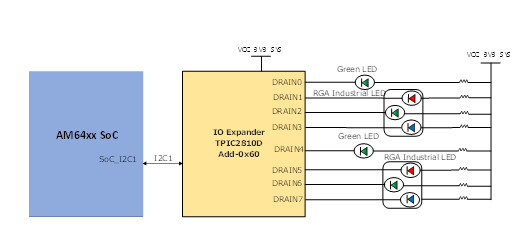SPRUJ64 September 2022
- Abstract
- Trademarks
- 1Key Features
- 2AM64x SKEVM Overview
- 3Functional Block Diagram
-
4System Description
- 4.1 Clocking
- 4.2 Reset
- 4.3 Power Requirements
- 4.4 Configuration
- 4.5 JTAG
- 4.6 Test Automation
- 4.7 UART Interface
- 4.8 Memory Interfaces
- 4.9 Ethernet Interface
- 4.10 USB 3.0 Interface
- 4.11 PRU Connector
- 4.12 User Expansion Connector
- 4.13 MCU Connector
- 4.14 Interrupt
- 4.15 I2C Interface
- 4.16 IO Expander (GPIOs)
- 5Known Issues and Modifications
- 6Revision History
4.9.3 Industrial Application LEDs for Indication
There are 8 LEDs connected to an I2C-based LED driver (TPIC2810D), which is controlled by the SoC through the I2C1 port. These 8 LEDs can be toggled based on the user application. Primarily these eight LEDs are meant for Industrial application.
 Figure 4-16 Ethernet
Interface - LEDs
Figure 4-16 Ethernet
Interface - LEDs